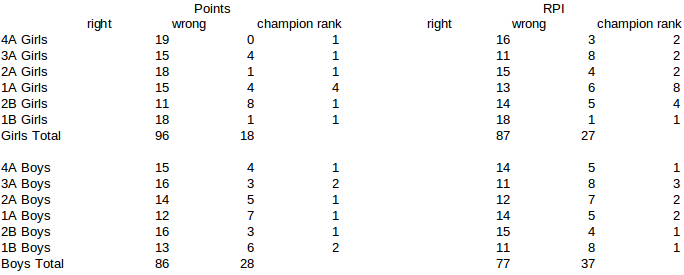
How did the rankings do?
The final rankings for Points and RPI, if used for predicting outcome of games, got the below portions of games 'right' for 2014-2015 season:
Points, Girls: 87.8% (3565 right 496 wrong)
Points, Boys: 82.9% (3375 right, 696 wrong)
RPI, Girls, 87.8% (3564 right, 497 wrong)
RPI, Boys 83.6% (3402 right, 669 wrong)
The final ratings incorporate the game results being checked, which is kind of cheating for posting a success rate. How did the ratings perform for predicting outcome of games based on the previous results? That is, for games of the day, how did the ratings for the previous day perform?
Points, Girls: 84.0% (2982 right, 567 wrong)
Point, Boys: 79.1% (2736 right, 723 wrong)
RPI, Girls: 78.7% (2916 right, 789 wrong)
RPI, Boys: 74.6% (2778 right, 948 wrong)
Note that the number of games predicted is lower since each rating algorithm takes several games to create a rating. Some early season games would not have a Points or RPI rating for both teams prior to the game. The overall accuracy is lower. This may be attributed to basing early season ratings on fewer games, resulting in a less accurate rating. RPI is able to be computed with fewer games than Points, which may give an advantage to Points.
What many use ratings for is to determine the 'best' team. In Oregon, seedings, and even entry into the State Tournament are based on ratings. How well did Points and RPI do in determining the best teams? How well did they do in predicting the outcome of the State Tournaments?
Consider the ratings on February 22, 2015, after the completion of district tournaments and prior to the State regionals. Girls. Boys. Of the twelve gender/classification rankings, the top ranked team in Points ranking went on to win the State Tournament in nine cases. For RPI, the top ranked team went on to win the State Tournament in four cases.

Points rating actually had a perfect bracket for the 4A Girls. I have often felt that the girls' tournaments have been fairly predictable. Although there were very close games in the 4A Girls' tournament this year, a perfect bracket may be something less than a lottery accomplishment. However, Points in nearly all cases out predicted RPI for outcome of State Tournaments in 2015. In the two cases where RPI had more tournament games 'right', Points had the champion. RPI did not.
Another observation is that both rankings performed better with girls tournaments than boys. Although I have paid more attention to girls games than boys, it has been my impression over the years that upsets occur more frequently in boys games than girls. If an upset is defined as a game outcome not conforming to the previous results, that would be borne out by the above table.